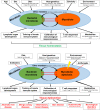The mammalian mycobiome: A complex system in a dynamic relationship with the host
- PMID: 30255552
- PMCID: PMC6586165
- DOI: 10.1002/wsbm.1438
The mammalian mycobiome: A complex system in a dynamic relationship with the host
Abstract
Mammalian barrier surfaces are densely populated by symbiont fungi in much the same way the former are colonized by symbiont bacteria. The fungal microbiota, otherwise known as the mycobiota, is increasingly recognized as a critical player in the maintenance of health and homeostasis of the host. Here we discuss the impact of the mycobiota on host physiology and disease, the factors influencing mycobiota composition, and the current technologies used for identifying symbiont fungal species. Understanding the tripartite interactions among the host, mycobiota, and other members of the microbiota, will help to guide the development of novel prevention and therapeutic strategies for a variety of human diseases. This article is categorized under: Physiology > Mammalian Physiology in Health and Disease Laboratory Methods and Technologies > Genetic/Genomic Methods Models of Systems Properties and Processes > Organismal Models.
Keywords: host-microbe interactions; immunology; microbiome; mycobiome; mycobiota.
© 2018 The Authors. WIREs Systems Biology and Medicine published by Wiley Periodicals, Inc.
Conflict of interest statement
The authors have declared no conflicts of interest for this article.
Figures

References
-
- Abarenkov, K. , Henrik Nilsson, R. , Larsson, K. H. , Alexander, I. J. , Eberhardt, U. , Erland, S. , … Koljalg, U. (2010). The UNITE database for molecular identification of fungi—Recent updates and future perspectives. New Phytologist, 186(2), 281–285. 10.1111/j.1469-8137.2009.03160.x - DOI - PubMed
-
- Angebault, C. , Djossou, F. , Abelanet, S. , Permal, E. , Ben Soltana, M. , Diancourt, L. , … Bougnoux, M. E. (2013). Candida albicans is not always the preferential yeast colonizing humans: A study in Wayampi Amerindians. Journal of Infectious Diseases, 208(10), 1705–1716. 10.1093/infdis/jit389 - DOI - PubMed
-
- Arts, R. J. , Novakovic, B. , Ter Horst, R. , Carvalho, A. , Bekkering, S. , Lachmandas, E. , … Netea, M. G. (2016). Glutaminolysis and fumarate accumulation integrate immunometabolic and epigenetic programs in trained immunity. Cell Metabolism, 24(6), 807–819. 10.1016/j.cmet.2016.10.008 - DOI - PMC - PubMed
Publication types
MeSH terms
Grants and funding
LinkOut - more resources
Full Text Sources
Other Literature Sources
Medical

